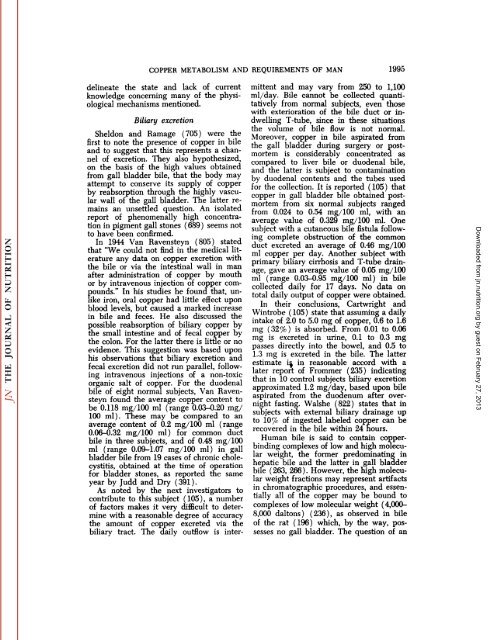conspectus of researchon copper metabolism and requirements
conspectus of researchon copper metabolism and requirements
conspectus of researchon copper metabolism and requirements
Create successful ePaper yourself
Turn your PDF publications into a flip-book with our unique Google optimized e-Paper software.
COPPER METABOLISM AND REQUIREMENTS OF MAN 1995<br />
delineate the state <strong>and</strong> lack <strong>of</strong> current<br />
knowledge concerning many <strong>of</strong> the physi<br />
ological mechanisms mentioned.<br />
Biliary excretion<br />
Sheldon <strong>and</strong> Ramage (705) were the<br />
first to note the presence <strong>of</strong> <strong>copper</strong> in bile<br />
<strong>and</strong> to suggest that this represents a chan<br />
nel <strong>of</strong> excretion. They also hypothesized,<br />
on the basis <strong>of</strong> the high values obtained<br />
from gall bladder bile, that the body may<br />
attempt to conserve its supply <strong>of</strong> <strong>copper</strong><br />
by reabsorption through the highly vascu<br />
lar wall <strong>of</strong> the gall bladder. The latter re<br />
mains an unsettled question. An isolated<br />
report <strong>of</strong> phenomenally high concentra<br />
tion in pigment gall stones (689 ) seems not<br />
to have been confirmed.<br />
In 1944 Van Ravensteyn (805) stated<br />
that "We could not find in the medical lit<br />
erature any data on <strong>copper</strong> excretion with<br />
the bile or via the intestinal wall in man<br />
after administration <strong>of</strong> <strong>copper</strong> by mouth<br />
or by intravenous injection <strong>of</strong> <strong>copper</strong> com<br />
pounds." In his studies he found that, un<br />
like iron, oral <strong>copper</strong> had little effect upon<br />
blood levels, but caused a marked increase<br />
in bile <strong>and</strong> feces. He also discussed the<br />
possible reabsorption <strong>of</strong> biliary <strong>copper</strong> by<br />
the small intestine <strong>and</strong> <strong>of</strong> fecal <strong>copper</strong> by<br />
the colon. For the latter there is little or no<br />
evidence. This suggestion was based upon<br />
his observations that biliary excretion <strong>and</strong><br />
fecal excretion did not run parallel, follow<br />
ing intravenous injections <strong>of</strong> a non-toxic<br />
organic salt <strong>of</strong> <strong>copper</strong>. For the duodenal<br />
bile <strong>of</strong> eight normal subjects, Van Raven<br />
steyn found the average <strong>copper</strong> content to<br />
be 0.118 mg/100 ml (range 0.03-0.20 mg/<br />
100 ml). These may be compared to an<br />
average content <strong>of</strong> 0.2 mg/100 ml (range<br />
0.06-0.32 mg/100 ml) for common duct<br />
bile in three subjects, <strong>and</strong> <strong>of</strong> 0.48 mg/100<br />
ml (range 0.09-1.07 mg/100 ml) in gall<br />
bladder bile from 19 cases <strong>of</strong> chronic chole<br />
cystitis, obtained at the time <strong>of</strong> operation<br />
for bladder stones, as reported the same<br />
year by Judd <strong>and</strong> Dry ( 391 ).<br />
As noted by the next investigators to<br />
contribute to this subject ( 105), a number<br />
<strong>of</strong> factors makes it very difficult to deter<br />
mine with a reasonable degree <strong>of</strong> accuracy<br />
the amount <strong>of</strong> <strong>copper</strong> excreted via the<br />
biliary tract. The daily outflow is inter<br />
mittent <strong>and</strong> may vary from 250 to 1,100<br />
ml/day. Bile cannot be collected quanti<br />
tatively from normal subjects, even those<br />
with exterioration <strong>of</strong> the bile duct or in<br />
dwelling T-tube, since in these situations<br />
the volume <strong>of</strong> bile flow is not normal.<br />
Moreover, <strong>copper</strong> in bile aspirated from<br />
the gall bladder during surgery or post<br />
mortem is considerably concentrated as<br />
compared to liver bile or duodenal bile,<br />
<strong>and</strong> the latter is subject to contamination<br />
by duodenal contents <strong>and</strong> the tubes used<br />
for the collection. It is reported ( 105) that<br />
<strong>copper</strong> in gall bladder bile obtained post<br />
mortem from six normal subjects ranged<br />
from 0.024 to 0.54 mg/100 ml, with an<br />
average value <strong>of</strong> 0.329 mg/100 ml. One<br />
subject with a cutaneous bile fistula follow<br />
ing complete obstruction <strong>of</strong> the common<br />
duct excreted an average <strong>of</strong> 0.46 mg/100<br />
ml <strong>copper</strong> per day. Another subject with<br />
primary biliary cirrhosis <strong>and</strong> T-tube drain<br />
age, gave an average value <strong>of</strong> 0.05 mg/100<br />
ml (range 0.03-0.95 mg/100 ml) in bile<br />
collected daily for 17 days. No data on<br />
total daily output <strong>of</strong> <strong>copper</strong> were obtained.<br />
In their conclusions, Cartwright <strong>and</strong><br />
Wintrobe ( 105) state that assuming a daily<br />
intake <strong>of</strong> 2.0 to 5.0 mg <strong>of</strong> <strong>copper</strong>, 0.6 to 1.6<br />
mg (32%) is absorbed. From 0.01 to 0.06<br />
mg is excreted in urine, 0.1 to 0.3 mg<br />
passes directly into the bowel, <strong>and</strong> 0.5 to<br />
1.3 mg is excreted in the bile. The latter<br />
estimate is, in reasonable accord with a<br />
later report <strong>of</strong> Frommer (235) indicating<br />
that in 10 control subjects biliary excretion<br />
approximated 1.2 mg/day, based upon bile<br />
aspirated from the duodenum after over<br />
night fasting. Walshe (822) states that in<br />
subjects with external biliary drainage up<br />
to 107' <strong>of</strong> ingested labeled <strong>copper</strong> can be<br />
recovered in the bile within 24 hours.<br />
Human bile is said to contain <strong>copper</strong>binding<br />
complexes <strong>of</strong> low <strong>and</strong> high molecu<br />
lar weight, the former predominating in<br />
hepatic bile <strong>and</strong> the latter in gall bladder<br />
bile (263, 266). However, the high molecu<br />
lar weight fractions may represent artifacts<br />
in Chromatographie procedures, <strong>and</strong> essen<br />
tially all <strong>of</strong> the <strong>copper</strong> may be bound to<br />
complexes <strong>of</strong> low molecular weight (4,000-<br />
8,000 daltons) (236), as observed in bile<br />
<strong>of</strong> the rat ( 196) which, by the way, pos<br />
sesses no gall bladder. The question <strong>of</strong> an<br />
Downloaded from<br />
jn.nutrition.org<br />
by guest on February 27, 2013
















